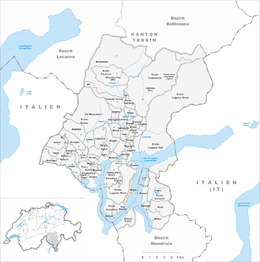Melide, Switzerland
| Melide | ||
|---|---|---|

Melide causeway
|
||
|
||
| Coordinates: 45°57′N 8°57′E / 45.950°N 8.950°ECoordinates: 45°57′N 8°57′E / 45.950°N 8.950°E | ||
| Country | Switzerland | |
| Canton | Ticino | |
| District | Lugano | |
| Government | ||
| • Mayor | Sindaco | |
| • Parliament |
Consiglio comunale with 20 members |
|
| Area | ||
| • Total | 1.67 km2 (0.64 sq mi) | |
| Elevation | 279 m (915 ft) | |
| Population (Dec 2015) | ||
| • Total | 1,800 | |
| • Density | 1,100/km2 (2,800/sq mi) | |
| Postal code | 6815 | |
| SFOS number | 5198 | |
| Surrounded by | Bissone, Brusino Arsizio, Campione d'Italia (IT-CO), Lugano | |
| Website |
www SFSO statistics |
|
Melide is a municipality in the district of Lugano in the canton of Ticino in Switzerland. The village lies very close to the mountain Monte San Salvatore and is directly on the Lake of Lugano. The Melide causeway to the east was built to make it possible to cross to Bissone and to allow a north-south highway to be built.
Melide is known worldwide for the famous Swissminiatur, a museum that shows famous buildings in Switzerland presented in miniature form.
Melide is first mentioned in 1034 as Melede. It was originally ruled by Como. After ownership transferred to Milan in the first half of the 15th Century, Melide was required to furnish five soldiers for the Duke of Milan. In 1482, a toll and customs station is first mentioned in Melide.
Until 1427 it was part of the parish of Lugano, followed by the parish of Carona. It became an independent parish in 1525. As the excavations of 1991-92 showed, the parish church of SS Quirico e Giulitta developed in several construction stages during the 6th and 7th Centuries. It was rebuilt in 1590 by Domenico Fontana. The S. Spirito Hospital was first mentioned in 1498 and was affiliated with Church of the S. Spirito Hospital in Rome. It was later abandoned and demolished in 1911. The Chapel of S. Croce is from 1626.
In 1555 the Swiss Confederation Tagsatzung granted Melide, Bissone and Morcote a monopoly on the sale of fish in Lugano. Fishing, together with agriculture and viticulture was the main sources of income in the village. The rest of the income for the village comes from the emigration of artisans and artists, including the Fontana and Castelli families. After the construction of the main road in 1818, a ferry opened in the settlement of La Punta the following year. The ferry helped the economic development of the village until the construction of the Melide causeway between 1844-47. The 817 meters (2,680 ft) long structure added a railroad line in 1874 and since the second half of the 1960s, a highway. In the 18th Century lime kilns opened in the village. In the 19th Century various manufacturers of tobacco, alcohol, bells, boats, soap and ink opened. The tourist industry started in the 19th Century and is still a major industry in Melide. In 1959, Swissminiatur, with miniature models of Swiss towns and buildings, opened.
...
Wikipedia




